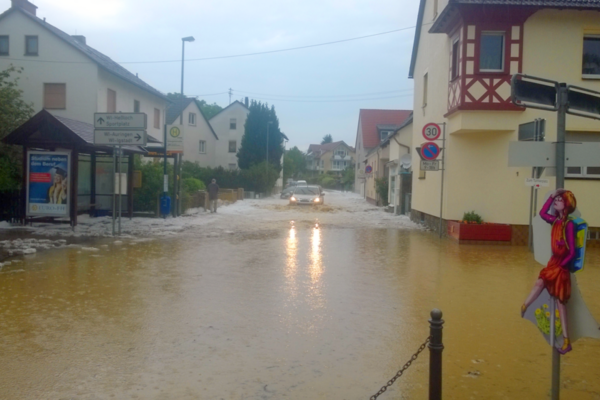Heavy rain in Wiesbaden
In the past, heavy rainfall events in Wiesbaden have sometimes caused major damage.
Floods and heavy rain - what are the differences?
Flooding can be caused by both high water and heavy rainfall. However, they differ in important respects: Floods are caused by rising water levels in rivers and streams. These are often the result of large-scale weather conditions and intensive continuous rainfall in the wider catchment area. Melting snow upstream also heralds possible flooding, sometimes days in advance. In contrast, flooding caused by heavy rainfall is not tied to the proximity of a body of water, but can occur over a wide area. They are the result of local and sudden downpours and are therefore difficult to predict in terms of both time and location. Dried out or frozen ground, in which rain cannot seep away, also intensifies such flash floods. Sometimes the effects of floods and heavy rainfall overlap: This is when small streams in narrow valleys and with small catchment areas are unable to drain off sudden masses of water.
Heavy rain in Wiesbaden
This situation exists in Wiesbaden, for example, at the Rambach, which flows through a narrow valley surrounded by steep slopes towards the city center. Within a short space of time, the Rambach can become a torrential river during heavy rainfall. The last two particularly devastating events of this kind occurred in 1999 and 2014. Since then, the city has already done a lot to protect this area from flooding - including as a result of heavy rainfall.
Extreme rainfall can also trigger flooding in large areas of Wiesbaden - regardless of streams or steep slopes. One example of this is the summer of 2016: heavy rain and hail led to many flooded cellars in the eastern parts of the city. In 2020, the environmental office of the state capital of Wiesbaden had simulations of heavy rainfall runoff on the Wäschbach calculated for the eastern suburbs. The other six water systems Lindenbach, Mosbach, Salzbach, Rambach, Wickerbach and the smaller watercourses in the Amöneburg, Kastel and Kostheim areas will follow in 2022. The aim is to identify areas for which protective measures make sense. It is particularly important here that water is retained in the area and the runoff is slowed down in a controlled manner - see link at the bottom of the page.
An issue with many stakeholders
Heavy rain affects many areas in the state capital of Wiesbaden. Various departments will continue to work closely together in the coming years in order to better prepare the city for such events. Catalogs of measures for climate adaptation with regard to heavy rain are being developed. In addition, maps are being created that make vulnerable areas visible and can serve as a basis for planning and action. Private precautions are also important - similar to those taken by residents in flood-prone river basins. It plays a central role in protecting against the consequences of heavy rainfall.
Further information
Contact us
Environmental Agency
Address
65189 Wiesbaden
Postal address
65029 Wiesbaden
Arrival
Notes on public transport
Bus stop Statistisches Bundesamt; bus lines 16, 22, 27, 28, 37, 45, X26, x72, 262
Telephone
Information on accessibility
- Barrier-free access is available
- The WC is barrier-free
